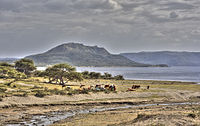
Photo from wikipedia
Although bacteria play key roles in aquatic food webs and biogeochemical cycles, information on the seasonal succession of bacterial communities in lakes is still far from complete. Here, we report… Click to show full abstract
Although bacteria play key roles in aquatic food webs and biogeochemical cycles, information on the seasonal succession of bacterial communities in lakes is still far from complete. Here, we report results of an integrative study on the successional trajectories of bacterial communities in a seasonally stratified lake with an anoxic hypolimnion. The bacterial community composition of epilimnion, metalimnion, and hypolimnion diverged during summer stratification and converged when the lake was mixed. In contrast, bacterial communities in the sediment remained relatively stable over the year. Phototrophic Cyanobacteria and heterotrophic Actinobacteria, Alphaproteobacteria and Planktomycetes were abundant in the aerobic epilimnion, Gammaproteobacteria (mainly Chromatiaceae) dominated in the metalimnion, and Chlorobi, Betaproteobacteria, Deltaproteobacteria, and Firmicutes were abundant in the anoxic sulfidic hypolimnion. Anoxic but nonsulfidic conditions expanded to the surface layer during fall turnover, when the epilimnion, metalimnion and upper hypolimnion mixed. During this period, phototrophic sulfur bacteria (Chromatiaceae and Chlorobi) disappeared, Polynucleobacter (Betaproteobacteria) and Methylobacter (Gammaproteobacteria) spread out from the former meta- and hypolimnion to the surface layer, and Epsilonproteobacteria dominated in the bottom water layer. Cyanobacteria and Planktomycetes regained dominance in early spring, after the oxygen concentration was restored by winter mixing. In total, these results show large spatio-temporal changes in bacterial community composition, especially during transitions from oxic to anoxic and from sulfidic to nonsulfidic conditions.
Journal Title: Frontiers in Microbiology
Year Published: 2017
Link to full text (if available)
Share on Social Media: Sign Up to like & get
recommendations!